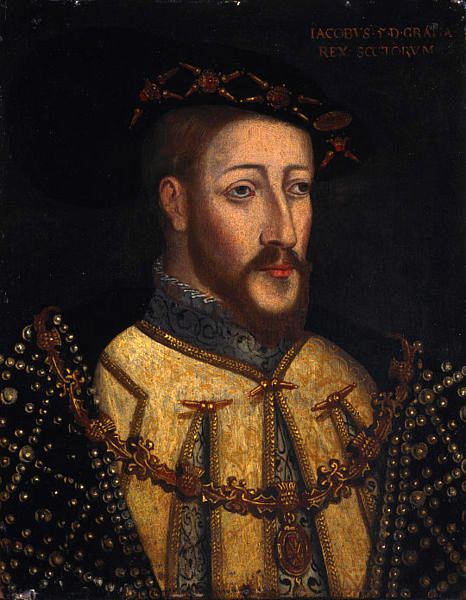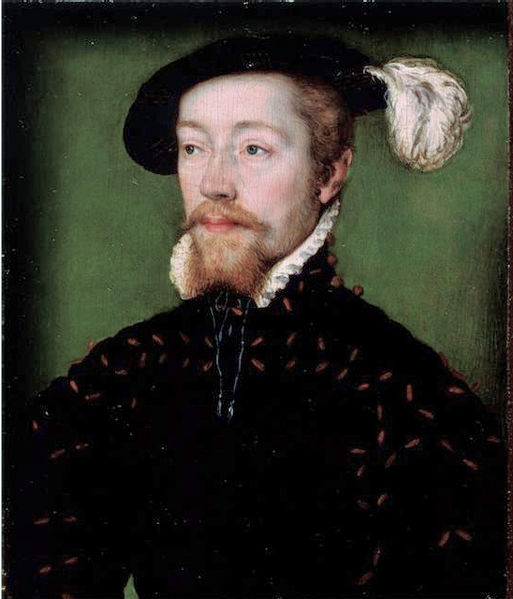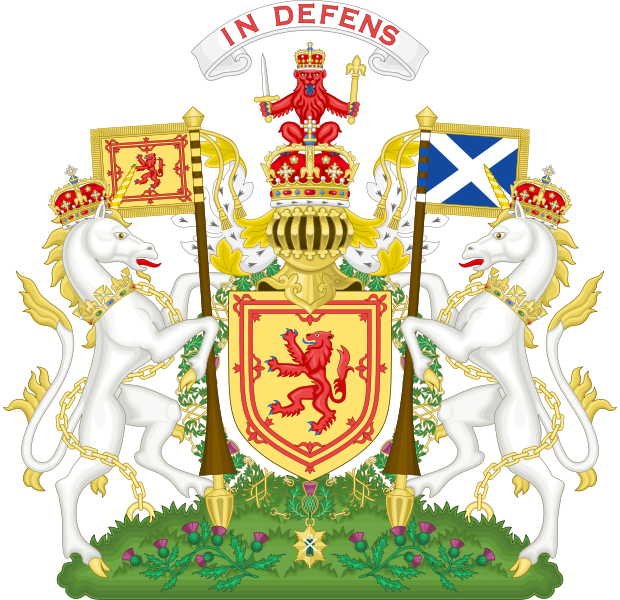<Back to Index>
- Geologist John Whitehurst, 1713
- Poet José Basílio da Gama, 1740
- King of Scots James V, 1512
PAGE SPONSOR



James V (10 April 1512 – 14 December 1542) was King of Scots from 9 September 1513 until his premature death at the age of 30, which followed the Scottish defeat at the Battle of Solway Moss. His only surviving legitimate child, Mary, succeeded him to the throne when she was just six or seven days old.
The son of King James IV of Scotland and his queen, Margaret Tudor of England, he was born on 10 April 1512, at Linlithgow Palace, West Lothian, and was just seventeen months old when his father was killed at the Battle of Flodden Field on 9 September 1513.
He was crowned in the Chapel Royal at Stirling Castle on 21 September 1513. During his childhood, the country was ruled by regents, first by his mother, Margaret Tudor (sister of King Henry VIII of England), until she remarried the following year, and thereafter by John Stewart, 2nd Duke of Albany, who was himself next in line for the throne after James and his younger brother, the posthumously - born Alexander Stewart, Duke of Ross. Other regents included Robert Maxwell, 5th Lord Maxwell a member of the council of Regency who was also bestowed as Regent of Arran, the largest island in the Firth of Clyde. In February 1517, James came from Stirling to Holyrood house but during an outbreak of plague in the city he was moved to the care of De la Bastie at nearby rural Craigmillar Castle. At Stirling, the 10 year old James had a guard of 20 footmen dressed in his colours, red and yellow. When he went to the Park below the Castle, 'by secret and in right fair and soft wedder (weather),' six horsemen would scour the countryside two miles roundabout for intruders. Poets wrote his own nursery rhymes, advising him on royal behaviour. William Stewart in his Princelie Majestie counselled against ice - skating:
An impression of the Scottish court at Holyroodhouse on All Saints day 1524 is given by a letter of an English diplomat, Thomas Magnus: "trumpets and shamulles did sounde and blewe up mooste pleasauntely." In 1525, Archibald Douglas, 6th Earl of Angus,
the young king's stepfather, took custody of James and held him as a
virtual prisoner for three years, exercising power on his behalf. When
James and his mother came to Edinburgh on 20 November 1526, she stayed
in the chambers at Holyroodhouse which Albany had used, and James used
the rooms above. In February 1527, Henry Fitzroy, Duke of Richmond sent
James twenty hunting hounds and a huntsman. Magnus thought the Scottish
servant sent with this request was intended to note the form and
fashion of the Duke's household, for emulation in Scotland. James finally escaped from Angus's care in 1528 and assumed the reins of government himself. His first action as king was to remove Angus from the scene, and he then subdued the Border rebels and the chiefs of the Western Isles. As well as taking advice from his nobility, James had a team of professional lawyers and diplomats, including Adam Otterburn and Thomas Erskine of Haltoun. Even John Tennent of
Listonschiels, his pursemaster and yeoman of the wardrobe, was sent on
an errand to England, though he got a frosty reception. James
increased his income by tightening control over royal estates and from
the profits of justice, customs and feudal rights. He also gave his
illegitimate sons lucrative benefices, diverting substantial church
wealth into his coffers. James spent a large amount of his wealth on
building work at Stirling Castle, Falkland Palace, Linlithgow Palace and Holyrood and built up a collection of tapestries from those inherited from his father. Domestic and international policy was affected by the Reformation, especially after Henry VIII broke from the Catholic church. James V did not tolerate heresy and during his reign, a number of outspoken Protestants were persecuted. The most famous of these was Patrick Hamilton who was burned at the stake as a heretic at St Andrews in 1528. Later in the reign, the English ambassador Ralph Sadler tried
to encourage him to close the monasteries and take their revenue, so
that he would not have to keep sheep like a mean subject. James replied
that he had no sheep, he could depend on his good - father the King of
France, and it was against reason to close the abbeys which, "stand
these many years, and God's service maintained and kept in the same,
and I might have anything I require of them." (James however did keep sheep; after his death 600 were given to James Douglass of Drumlanrig). On 19 January 1537 Pope Paul III sent James a sword and cap symbolising his prayers that he would be strengthened against heresies from across the border. According to 16th century writers, his treasurer James Kirkcaldy of Grange tried to persuade him against the persecution of Protestants and to meet Henry VIII at York. Although Henry VIII sent his tapestries to York in September 1541 ahead of the meeting, James did not come. James sailed to France for his first marriage and built up the royal fleet. In 1540 he sailed to Kirkwall in Orkney, then Lewis, in his ship the Salamander, first making a will in Leith, knowing this to be, 'uncertane aventuris.'
James V had nine known illegitimate children, at least three of whom were fathered before the age of 20. In addition to these aristocratic liaisons, David Lyndsay described the king's other affairs in the poem, The Answer to the Kingis Flyting: 'ye be now strang lyke ane elephand, And in till Venus werkis maist vailyeand.' The young King was said to have been encouraged in his amorous affairs by the Angus regime to keep him distracted from politics. Many of the sons of his aristocatic mistresses entered ecclesiastical careers. As early as August 1517, the Treaty of Rouen provided that if the Auld Alliance between France and Scotland was maintained, James should have a French royal bride. Yet the daughters of Francis I of France were promised elsewhere or sickly. On 6 March 1536, a contract was made for James V to marry Mary of Bourbon, daughter of the Duke of Vendôme. She would have a dowry as if she were a Princess. James visited her at St. Quentin in Picardy, but then went south to meet Francis I of France. During his stay in France, in October 1536, James went boar hunting at Loches with Francis I, his son the Dauphin, the King of Navarre and Ippolito II d'Este. James renewed the Auld Alliance and fulfilled the 1517 Treaty of Rouen, on 1 January 1537, by marrying Madeleine of Valois, the king's daughter, in Notre Dame de Paris.
Francis I had previously insisted that his daughter's health was too
poor for marriage. The wedding was a great event: Francis I made a
contract with six painters for the splendid decorations, and there were
days of jousting at the Louvre. At
his entry to Paris, James wore a coat described as “sad cramasy velvet
slashed all over with gold cut out on plain cloth of gold fringed with
gold and all cut out, knit with horns and lined with red taffeta.” James
V so liked red clothing that, during the wedding festivities, he upset
the city dignitaries who had sole right to wear that colour in
processions. They noted he could not speak a word of French. When James was at Compiegne on 25 February 1537, a messenger from Pope Paul III arrived with a gift of a sword and hat. Madeleine
did not enjoy good health. They returned from France on 19 May 1537,
arriving at Leith, his Scottish fleet accompanied with ten great French
ships. As the couple sailed northwards, some Englishmen had come aboard off Bridlington and Scarborough. While the fleet was off Bamburgh on 15 May, three English fishing boats supplied fish and the King's butcher landed in Northumbria to buy meat. The English border authorities were dismayed by this activity. Madeleine was consumptive, and died soon after in July 1537. James then proceeded to marry by proxy, on 12 June 1538, Mary of Guise, daughter of Claude, Duke of Guise and
widow of Louis of Orleans, Duke of Longueville. Mary already had two
sons from her first marriage, and the union produced two sons. However,
both died in April 1541, just eight days after baby Robert was
baptised. Their daughter and James's only legitimate child was born in
1542 at Linlithgow Palace. According
to legend, James was nicknamed "King of the Commons" as he would
sometimes travel around Scotland, disguised as a common man, describing
himself as the Gudeman of Ballengeich ('Gudeman' means 'landlord' or 'farmer', and 'Ballengeich' was the nickname of a road next to Stirling Castle – meaning 'windy pass' in Gaelic). James was also a keen lute player. In 1562 Sir Thomas Wood reported that James had “a singular good ear and could sing that he had never seen before” (sight - read)
but his voice was “rawky” and “harske.” At court, James maintained a
band of Italian musicians who adopted the name Drummond. The historian
Andrea Thomas makes a useful distinction between the loud music
provided at ceremonies and professionals and instruments employed for
more private occasion. This quieter music included a consort of viols played by four Frenchmen led by Jacques Columbell. It seems certain that David Peebles wrote music for James V, and probable that the Scottish composer Robert Carver was in royal employ, though evidence is lacking. As a patron of poets and authors he supported William Stewart and John Bellenden, who translated the Latin History of Scotland compiled in 1527 by Hector Boece, into verse and prose. Sir David Lindsay of the Mount the Lord Lyon, the head of the Lyon Court and diplomat, was a prolific poet. He produced an interlude at Linlithgow Palace thought to be a version of his play The Thrie Estaitis in 1540. James also attracted the attention of international authors. The French poet Pierre de Ronsard, who had been a page of Madeleine of Valois, offered unqualified praise; De vertus, et de l'honneur, et guerre amoureux When he married Mary of Guise, Giovanni Ferrerio, an Italian scholar who had been at Kinloss Abbey in Scotland, dedicated to the couple a new edition of his work, On the true significance of comets against the vanity of astrologers. Like Henry VIII, James employed many foreign artisans and craftsmen in order to enhance the prestige of his renaissance court. Robert Lindsay of Pitscottie listed their professions; he
plenished the country with all kind of craftsmen out of other
countries, as French - men, Spaniards, Dutch men, and Englishmen, which
were all cunning craftsmen, every man for his own hand. Some were
gunners, wrights, carvers, painters, masons, smiths, harness - makers
(armourers), tapesters, broudsters, taylors, cunning chirugeons,
apothecaries, with all other kind of craftsmen to apparel his palaces. One
technological initiative was a special mill for polishing armour at
Holyroodhouse next to his mint. The mill had a pole drive 32 feet long powered by horses. Mary of Guise's mother Antoinette of Bourbon sent him an armourer. In October 1538 the French armourer made steel plates for his jousting saddles, and delivered a skirt of plate armour in February 1540. When
James took steps to suppress the circulation of salanderous ballads and
rhymes against Henry VIII, Henry sent Fulke ap Powell, Lancaster Herald, to give thanks and to make arrangements for the present of a lion for James's menagerie of exotic pets.
The
death of his mother in 1541 removed any incentive for peace with
England, and war broke out. Initially the Scots won a victory at the Battle of Haddon Rig in 1542, but later that year, they suffered a serious defeat at the Battle of Solway Moss.
He took ill shortly after this, on 6 December, by some accounts this
was a nervous collapse caused by the defeat, although some historians
consider that it may just have been an ordinary fever. John Knox later described his final movements in Fife. Whatever the cause of his illness, he was on his deathbed at Falkland Palace when his only surviving legitimate child, a girl, was born. Sir George Douglas of Pittendreich brought
the news of the king's death to Berwick. He said James died at midnight
on Thursday 15 December; the king was talking but delirious and spoke
no "wise words." According to George Douglas in his delirium James
lamented the capture of his banner and Oliver Sinclair at Solway Moss more than his other losses. An English chronicler suggested another cause of the king's grief was his discomfort on hearing of the murder of the English Somerset Herald, Thomas Trahern, at Dunbar. James was buried at Holyrood Abbey in Edinburgh. Before
he died, he is reported to have said, "it came wi a lass, it'll gang wi
a lass" ("It began with a girl and it will end with a girl"). This was a reference to the Stewart dynasty, and how it came to the throne through Marjorie, daughter of Robert the Bruce.
As it happened, his words came true, although not with his daughter
Mary but with the last monarch of the House of Stewart (then spelled
"Stuart"), Queen Anne, who was his great - great - great - granddaughter.
James was succeeded by his infant daughter, Mary, Queen of Scots. He was buried at Holyrood Abbey alongside Madeleine and
his two sons in January 1543. David Lindsay supervised the construction
of his tomb. One of his French artists, Andrew Mansioun, carved a lion
and an inscription in Roman letters measuring eighteen feet for the tomb, which was later destroyed. Scotland was ruled by Regent Arran and was soon drawn into the war of the Rough Wooing.
La douceur et la force illustroient son visage
Si que Venus et Mars en avoient fait partage"
[His royal bearing, and vigorous pursuit
of virtue, of honour, and love's war,
this sweetness and strength illuminate his face,
as if he were Venus and Mars' child.]